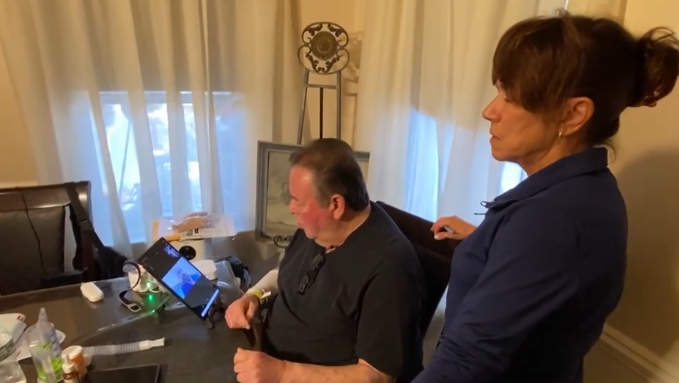With an average of 1,500 patients in emergency rooms a day in early September and wait times for inpatient rooms reaching nearly nine hours, Massachusetts General Hospital Brigham is easing capacity pressures by expanding home care. Steven Iannone is known for telling it like it is. “My filter is gone, it broke a long time ago,” Iannone says. That includes his own health issues. “For years I didn’t eat properly, I was picky with food, and that put me in congestive heart failure,” Iannone says. As the state’s hospital capacity crisis continues, he ended up in the emergency room at Massachusetts General Hospital Brigham. “You’re going to move slowly there. You might actually be in the emergency room for a day or two until they give you a bed,” Iannone says. That’s when he was offered another option: to go home and get hospital treatment there. “Anyone who’s in their own space is happiest, and that’s only natural,” Iannone said. Massachusetts General Hospital Brigham’s hospital-at-home program has been in place since 2017, but what started as a pilot program is now accelerating to ease capacity pressures. This month, the hospital-at-home reached a milestone of 70 beds, making it the largest hospital-at-home in the country. “We treat illnesses like heart disease, chronic obstructive pulmonary disease, and infectious diseases. The environment where patients feel most comfortable is when they’re at home,” said Heather O’Sullivan, president of home health at Massachusetts General Hospital Brigham. It’s a hospital-at-home level of care for hospitalized patients, including 24/7 vital sign monitoring, multiple visits a day by a care team, and virtual connections with doctors. And studies show it’s paying off. A Harvard Medical School study found that patients needed hospital-at-home care for an average of 6.3 days. And only 6.2% of patients needed to be admitted to a physical hospital facility during that time. The mortality rate during hospitalization at home was 0.5%. For Iannone, choosing to treat himself at home was the obvious choice. “I’m in my own home, my own chair, my own bed, my own food, that’s it. I have my family. Imagine having two nurses looking after me instead of 39 other people. How about that? How much better is that?” Iannone says. “My focus is solely on the patient. So the time I spend with the patient is entirely for the benefit of the patient. So if they have any questions, if they want me to do something, if they want to communicate with their health care provider, if they have any issues, if they want me to do something around the house, or if they want me to help them with something at home, I’m there to help them,” says Catherine Dugan, a paramedic instructor. This is a critical resource for patients and hospital staff, as emergency departments are often operating in what is called a “capacity disaster.” At the start of the day, there are more than 45 patients waiting for a hospital bed. They can’t keep up with the growing rate of demand for health care services. This is a national problem. “This care model, which delivers acute hospital care at home, allows us to take advantage of the spare beds in patients’ homes to support the care they need,” said Dr. Steven Dorner, an emergency physician at Massachusetts General Hospital Brigham. The model is now being implemented across the country. “It’s now widely adopted by more than 350 hospitals across the country. “Hospital-at-home is supported by federal and local regulations,” O’Sullivan said. And it continues to expand, aiming to reduce the burden on both hospitals and patients. “If you follow the rules, you’ll get better because you’re getting incredible care,” Iannone said. “It’s a more healing environment. Readmission rates after hospitalization at home are lower compared to traditional hospitalization,” O’Sullivan said. According to Massachusetts General Hospital Brigham, hospital-at-home also reduces infection rates for patients because they are less exposed to risk when they’re not hospitalized. The program is now expanding to 71 communities in Massachusetts connected to five hospitals at Massachusetts General Hospital Brigham. They’re also adding more types of patients they’re eligible for, which will soon include new moms who need hypertension treatment.
Brookline, Massachusetts —
With an average of 1,500 patients going to emergency rooms each day and wait times for hospital rooms reaching nearly nine hours in early September, Massachusetts General Hospital at the Brigham is easing capacity pressures by expanding home care services.
Steven Iannone is known for telling the truth.
“My filter is gone. And my filter broke a long time ago,” Iannone said.
That includes talking about his own health issues.
“If you spend years not eating right and eating food indulgently, you can end up in congestive heart failure,” Iannone said.
He was taken to the emergency room at Massachusetts General Hospital Brigham amid the state’s ongoing hospital capacity crisis.
“It’s going to be a slow process there. You might actually be there in emergency mode for a day or two before you can get into a bed,” Iannone said.
He was then presented with another option: to go home and receive treatment at a hospital there.
“Whoever is in their own space is the happiest. That’s common sense,” Iannone said.
Massachusetts General Hospital Brigham’s hospital-at-home program has been in place since 2017, but what started as a pilot program has now been accelerated to help ease capacity shortages.
This month, the Home Hospital reached the milestone of 70 beds, making it the largest home hospital in the country.
“We treat conditions like cardiac disease, chronic obstructive pulmonary disease and infectious diseases, and the environment in which patients feel most comfortable is the comfort of their own home,” said Heather O’Sullivan, director of home health care at Massachusetts General Hospital Brigham.
It’s hospitalization-level care received in the comfort of your own home, with 24/7 monitoring of vital signs, multiple daily visits from your care team, and the ability to connect virtually with your doctor.
And research shows that it’s working.
A Harvard Medical School study found that patients required home hospital care for an average of 6.3 days, and only 6.2% of those patients required admission to a physical hospital facility during that time. The mortality rate during home hospitalization was 0.5%.
Iannone says the choice to treat at home was the obvious one.
“I’m in my house, my chair, my bed, my food, that’s it, my family.
“Imagine having two nurses taking care of me instead of 39 other people? How good would that be?” Iannone said.
“My sole focus is on the patient, so the time I spend with them is solely for their benefit, so if they have a question, if they need something done, if they want to connect with a health care provider, if they’re having an issue, if they need help around the house or if they need help with something around the house, I’m there to help,” said Catherine Duggan, paramedic instructor.
Emergency departments, a critical resource for patients and hospital staff, often operate at what’s known as a “capacity disaster,” with more than 45 patients waiting for a hospital bed at the start of the day.
“We can’t keep up with the rate at which demand for health care services is increasing. This is a national problem. This model of care, bringing acute hospital care to the home, allows us to utilize spare beds in patients’ homes to support the care they need,” said Dr. Steven Dorner, an emergency physician at Massachusetts General Hospital at the Brigham.
This model is now being implemented across the country.
“The system is now widely adopted by more than 350 hospitals across the country, meaning hospital-at-home is supported by both federal and local regulations,” O’Sullivan said.
And it continues to expand, aiming to ease the burden on both hospitals and patients.
“If you follow the rules, you’re going to get better because you’re going to get incredible care,” Iannone said.
“It’s a more healing environment, and there are lower readmission rates after a home hospital stay compared to a traditional hospital stay,” O’Sullivan says.
Massachusetts General Hospital’s Brigham said home hospitals are also seeing lower infection rates among patients because they are less exposed to infection risks when they’re outside the hospital.
The program has now expanded to 71 communities across Massachusetts affiliated with five Massachusetts General Brigham Hospital locations.
Additional patient types are also being targeted and will soon include new moms who need treatment for high blood pressure.

